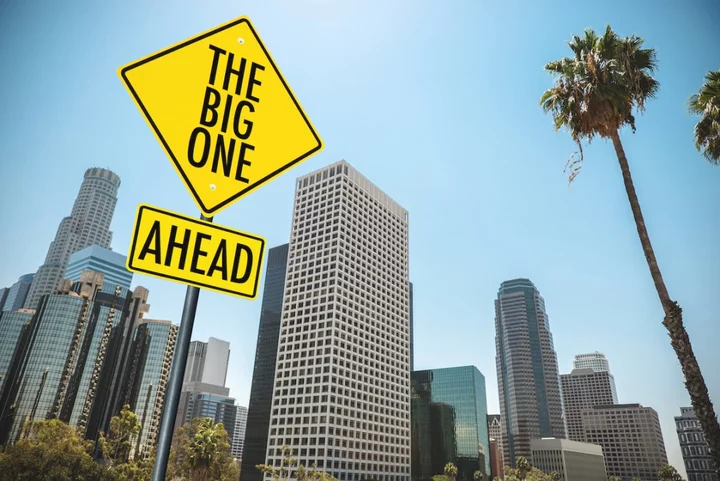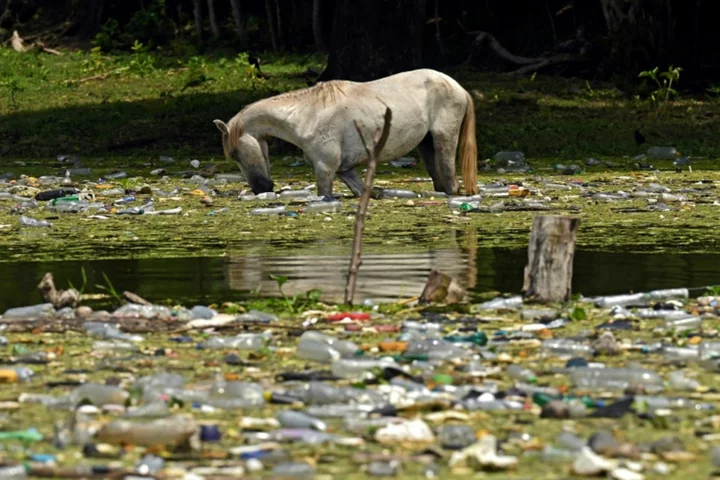In the middle of the driest California desert, just along the southerly State Route 86, you can find sun-bleached shells littering the ground.
They're telltale signs of a once colossal lake that has come and gone over the last thousands of years, a place called Lake Cahuilla. Today, the much smaller, and shrinking, Salton Sea takes its place. In a new geologic study, scientists have found Lake Cahuilla may have continually played a role in helping stoke major quakes along the southern portion of the infamous San Andreas Fault — which is overdue for a giant quake, a "big one" in Southern California. (Other big ones have certainly hit other parts of the fault, namely the devastating 1906 quake near San Francisco.) The mighty lake, however, hasn't filled to its max depth of over 300 feet since the early 1730s, back when George Washington was just born.
The San Andreas Fault is a fracture between two of Earth's giant slabs of rocky crust, the North American and Pacific plates. Where they meet in California, unimaginable pressure builds as they press into one another. The fault is continually stressed, accumulating some two centimeters of slip deficit annually. The southern portion of the fault historically releases this energy in powerful ruptures around every 180 years, give or take 40 years. But it hasn't budged in some 300 years.
"Eventually this will have to be released by a big earthquake," Yuri Fialko, a professor of geophysics at the Scripps Institution of Oceanography and coauthor of the research, told Mashable.
The research was recently published in the science journal Nature.
SEE ALSO: 4 things to know about California's strange earthquake droughtWithout the giant lake there, putting enormous pressure on the San Andreas and contributing to a more vulnerable fault, the coming big one — a Southern California quake that could cause some 1,800 deaths, $200 billion in damage, and untold disruption — might be further delayed. But, critically, the fault might also accumulate even more pressure, resulting in a more potent temblor.
Crucially, a potential delay isn't a reason to stop preparing for a bad earthquake, emphasized John Vidale, an earthquake researcher at the University of Southern California who had no role in the research. But an even bigger, delayed quake, if that comes to pass, isn't the end of the world. It at least allows people to better prepare, ensure more resilient structures, and beyond.
"I’d guess the additional time to enjoy the calm and prepare and better anticipate what is coming is a net gain over just getting it over with sooner," Vidale told Mashable.
The San Andreas Fault separating the massive Pacific and North American plates. Credit: USGS The outline of the former Lake Cahuilla shown in dark blue. The current Salton Sea is at center (filled with light blue), and the San Andreas Fault is designated "SAF." Credit: USGSTriggering the San Andreas Fault
The evidence for Lake Cahuilla triggering major temblors is compelling: Over the last thousand years or so, Colorado River water pouring into this low desert basin has filled the lake six times, according to geologic research. And during each fill, a significant quake occurred, the latest of which was in the 1720s.
"This was an amazing correlation that inspired the modeling part of our study," said Fialko.
Of course, a basic tenant of scientific research is that correlation does not mean causation. (See the ingenious Spurious Correlation website for a poignant detour into spurious correlations). But this correlation is strong. "It's very plausible," noted Vidale. What's more, the researchers were able to run advanced computer simulations, on a supercomputer at San Diego State University, allowing them to see how the lake triggered the earthquakes in this desert region.
A graph showing when Lake Cahuilla filled over the last thousand years. The lake levels are shown in light blue, whereas the corresponding earthquake time probabilities are shown by the dotted black lines below each lake fill episode. Credit: Hill, et al., 2023Faults, like the San Andreas, are held together by friction and intense pressure. "Anything that will relieve that pressure will nudge it closer to failure," explained Scripps' Fialko. Two primary factors pushed the southern San Andreas to failure, the researchers concluded. Both were caused by the ancient, giant lake:
Immense water pressed down on Earth's surface, just to the side of the actual fault line. This flexed the ground underneath, and ultimately acted to "unclench" the fault. Now, it could slip.
Lake water percolated down into the fault zone. This water, needing somewhere to go, tried to push apart two sides of the fault. "It encouraged the triggering," Fialko said.
A total of six sizable quakes shook Southern California when the lake filled. Over the last century, the much smaller, and less heavy, Salton Sea filled the desert basin, which is largely sustained by agricultural runoff. It's now evaporating. Water scarcity has increased in the hotter, drying West, and farmers have found ways to more efficiently irrigate crops, leading to less runoff flowing into the artificial sea. In our modern world, where the Colorado River now provides water to some 40 million people, there's certainly no water to spare for a sprawling natural lake. Expansive Lake Cahuilla will not come again, at least while civilization is here.
So the question looms: Without a giant lake potentially triggering quakes, when's the big one coming?
The high water line from Lake Cahuilla preserved on a hill in the Southern California desert. Credit: USGSWant more science and tech news delivered straight to your inbox? Sign up for Mashable's Light Speed newsletter today.
What is the earthquake risk from the San Andreas Fault?
It's clear the southern portion of the San Andreas is long overdo.
With no lake present, the "clamping pressure" on the fault increases. This should stabilize the infamous rupture, Fialko said.
But, crucially, there will still be other quakes. "It will not stop the next big earthquake from occurring," Fialko emphasized.
"Eventually there's going to be an earthquake whether the lake fills or not," added Vidale.
We just don't know when. "Earthquakes don't work like a clock," Fialko said. Eventually, maybe today, tomorrow, or in decades, the pressure building between the two plates will inevitably cause the fault to fail.
"Earthquakes don't work like a clock."Although we now know more, and continue to learn more about the enigmatic San Andreas, the crucial takeaway remains the same: "It underscores the need for preparedness," Fialko said. "Do everything you can to stay prepared."
Importantly, there are faults all over Southern California. Faults running parallel to the San Andreas. Faults running perpendicular to it. A fault running through Hollywood. Faults right off the coast. Ultimately, depending on where the quake hits along the San Andreas, the biggest risk to you might be something else, much closer to home.
A medical building severely damaged by the Northridge quake in 1994. Credit: Joe Sohm / Visions of America / Universal Images Group via Getty Images"Here in L.A., a lot of the risk is the fault right underneath us," said Vidale. "We have a lot of risks, and many of them aren't from the San Andreas."
How to prepare? There are a number of good resources. The USGS has valuable preparation info, as does the California Governor's Office of Emergency Services. In general, keep an earthquake disaster kit or storage area, have a family plan, and prepare your home for intense shaking.
The southern section of the San Andreas has been quiet. But that won't last forever.









